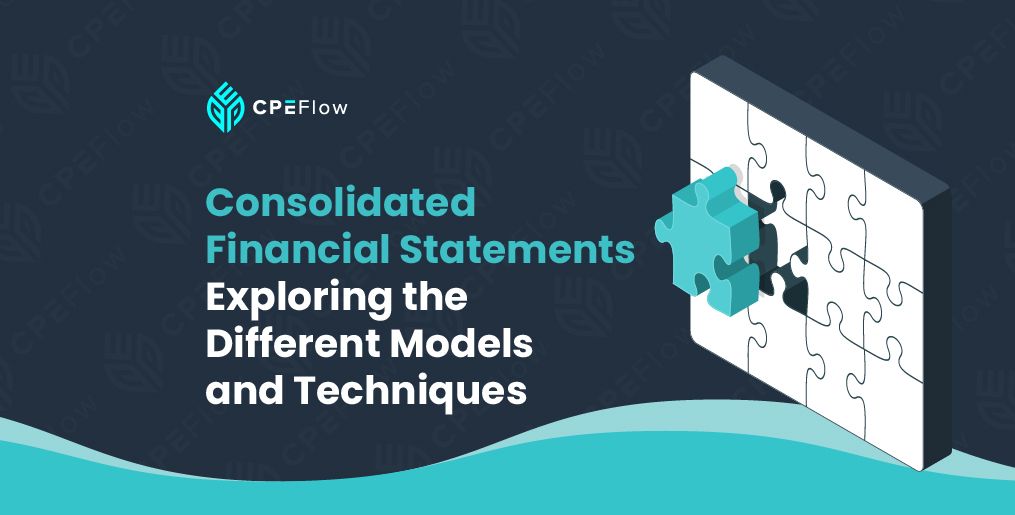Consolidated Financial Statements: Exploring the Different Models and Techniques
Jun 11
/
Nathan Liao, CMA

Trying to understand a company's overall financial health without consolidated statements is like completing a puzzle with only a few scattered pieces. You might spot patterns or trends, but the full picture only emerges when all the pieces fit together.
That's exactly what consolidated financial statements do. They combine the financial data of a parent company and all its subsidiaries into one unified set of statements. Instead of analyzing each entity separately, stakeholders can get a clear, comprehensive view of the financial position and performance of the entire corporate group.
This holistic approach is crucial for decision-makers, investors, and regulators who need to understand how the business operates and performs as a whole.
If you want to master the techniques for financial statement consolidation, check out CPE Flow's Consolidated Financials Course.
What are Consolidated Financial Statements?
Consolidated financial statements represent the financial position and health of a group of companies, which typically includes a parent company and its subsidiaries.
Rather than reporting each company separately, this process merges their data into a single set of statements to offer a more accurate picture of the parent organization's overall financial health.
Each subsidiary can still have its own financial report, but consolidation enables a comprehensive report to be produced for the entire corporate group.
The basic rule for consolidation is that the parent company must have control over the subsidiary. For example, it might own 50% of the subsidiary or have a strong voting share. This shows that it has a strong influence over its subsidiary's financial and operational decisions. In such cases, consolidation is essential, even if these subsidiaries are separate legal entities.
Examples of consolidated financial statements include a consolidated balance sheet, income statement, or cash flow statement.
Importance of Consolidated Financial Statements
Consolidated financials combine the data of the parent and its subsidiaries to give a full picture of a company's overall financial position. This helps investors, creditors, and regulators assess the group's true performance without having to piece together individual reports.
These statements are often required for regulatory compliance, especially for public companies or those operating in regulated markets.
But even when not mandatory, companies may still choose to prepare them to support tax planning, provide a clearer view to potential investors, or gain a complete picture of the entire entity's financial standing.
Get Exclusive Access & Special Discounts!
Get early bird access to new CPE courses and exclusive discounts only shared with our email subscribers.
The Two Consolidation Models
Two commonly used consolidation models are the Variable Interest Entity (VIE) and Voting Interest Entity (VOE) models.
These models can be utilized when a parent company has sufficient control or influence over another entity.
Variable Interest Entity for Consolidated Financials
A Variable Interest Entity (VIE) is a legal business structure in which a company has a controlling financial interest, not through voting rights, but through other arrangements, such as contracts or financial support.
VIEs typically have specific characteristics. For instance, they might lack enough capital to support their own operations without external financial support. Additionally, the equity holders may not have the power to steer decisions that will impact the entity's financial performance.
If such VIE indicators are present, the entity must be evaluated for consolidation. Under the VIE model, the company that is considered to be its primary beneficiary must consolidate the entity into its financial statements.
To be considered the primary beneficiary, a company must meet two key criteria:
- It has the authority to direct the activities that most affect the VIE's economic performance.
- It has the right to receive significant benefits or the obligation to absorb significant losses.
The company identified as the primary beneficiary of a variable interest entity (VIE) must include the VIE's assets, liabilities, and financial reports in its own consolidated financial statements. Updated guidance from the Financial Accounting Standards Board (FASB) emphasizes the need for greater transparency, so these companies must provide clear disclosures about their relationship with VIEs.
Voting Interest Model for Consolidated Financials
Under the VOE model, consolidation is performed when the parent company has a controlling financial interest in the entity, often through ownership of the majority of the voting interest. Essentially, the parent company has the power to direct key operational and financial decisions.
How controlling financial interest is determined depends on the type of entity involved. In the case of limited partnerships or similar entities, controlling financial interest is determined based on the rights of the limited partners as follows:
- Substantive Kick-Out Rights: If limited partners possess the substantive right to remove the general partner, they are considered to have control.
- Participating Rights: Rights that allow limited partners to participate in significant financial and operational decisions as part of the entity's usual business activities can also indicate control.
If such rights exist, the limited partnership is evaluated under the VOE model, and the party with these rights may need to consolidate the entity.
For corporations and other entities that aren't limited partnerships, control is generally presumed when a company owns more than 50% of the voting shares. This majority ownership typically requires the consolidation of the entity's financial statements.
The Different Consolidation Techniques
The method that should be used to prepare consolidated financial statements depends on the level of control or influence a parent company has over its subsidiaries or affiliates.
Below are the three main techniques used for consolidation:
Full Consolidation Method
The full consolidation method is applied when a parent company has a controlling financial interest in another entity. Under this method, the parent includes all of the subsidiary's assets, liabilities, income, and expenses in its consolidated financial statements.
Both the Voting Interest Entity (VOE) and Variable Interest Entity (VIE) models lead to full consolidation, provided certain criteria are met.
In the VOE model, this occurs when the parent holds a majority of the voting rights, substantial kick-out rights, or participating rights.
In the VIE model, full consolidation is required when the parent is identified as the primary beneficiary, where it has the power to make significant decisions or is greatly impacted by the subsidiary's gains and losses.
The full consolidation method is the most straightforward approach, as the parent company reports all of the subsidiary's assets, liabilities, and equity within its own financial statements.
Proportionate Consolidation Method
The proportionate consolidation method is similar to the full consolidation method, except that the company includes only its proportionate share of the entity's stake in its financial statements.
Under this approach, the proportionate share of the entity's assets, liabilities, revenues, and expenses is included in the parent company's financial statements based on its ownership percentage.
For example, if a company holds a 45% investment stake in another entity, it would report 45% of that entity's assets, liabilities, revenues, and expenses on its own financial statements. This allows the parent to reflect its partial interest in the entity without overstating total assets or liabilities.
However, it's worth noting that this method is rarely used and has largely been phased out. Regulatory bodies have mostly replaced this method with the equity method for such arrangements, making proportionate consolidation essentially a historical practice.
Equity Consolidation Method
The equity method is applied when a company holds significant influence over another entity. It is generally utilized when ownership ranges from 20% to 50% of the voting shares.
Under this method, the investor initially records the original investment amount as a cost in its financial statements. This investment value is then adjusted over time to reflect the investor's share of the investee's net income or loss.
Essentially, the equity method provides a streamlined way to reflect the economic impact of an investment in which the investor has a strong influence but not a controlling financial interest.
Using the Right Techniques When Consolidating Financial Statements
Choosing the appropriate consolidation technique is essential for accurate and transparent financial reporting. Each approach, whether you're using the full consolidation or equity method, reflects a different level of control and involvement.
Misapplying these models can distort key financial metrics and lead to compliance issues. That's why a solid grasp of when and how to consolidate is essential for anyone involved in financial reporting.
If you want to deepen your understanding of these concepts, feel free to check out CPE Flow's Consolidated Financials Course.
This comprehensive program covers everything from the foundational models to practical, real-world applications. It's designed to help you build confidence in applying the right techniques while you conveniently earn NASBA-approved CPE credits from your own home and at your own pace.
Thank you for reading,

Nathan Liao, CMA
Empty space, drag to resize
Nathan Liao, a Certified Management Accountant, educator, and influential business figure in the accounting industry, has dedicated over a decade to supporting more than 82,000 accounting and finance professionals in their pursuit of the CMA certification. As the visionary founder of CMA Exam Academy and CPE Flow, Nathan is committed to delivering premier online training solutions for the next generation of accounting and finance professionals.
Explore Our Self-Paced CPE Courses
CPE Flow
© 2022 - 2025 CPE Flow, LLC. All Rights Reserved.
Refund & Complaint Policies
Requests for refunds must be made in writing within 5 days of purchasing the course. No refunds or credits will be provided after this point or if the final assessment is completed. CPE Flow issues refunds within 30 days in the same format as the payment was received. The refund amount is based on the timeframe in which the request was submitted (see table).
| Request Timeframe |
Refund/Credit Amount |
|
≤ 2 Hours |
100% Refund* |
|
> 2 Hours ≤ 48 Hours |
90% Refund* or 100% Credit** |
|
> 48 Hours ≤ 5 Days |
0% Refund or 50% Credit** |
* If a credit card was used for purchase, the 3.5% credit card fee will be deducted from the refund amount.
**Credit can be applied towards the same offering at a later date or a different offering.
For complaints or concerns, please email support@cpeflow.com
